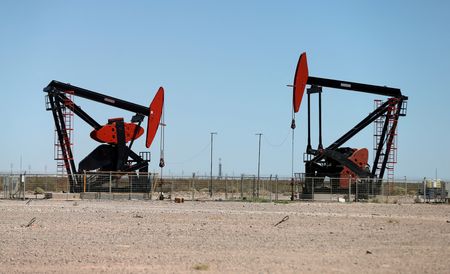
By Katya Golubkova
TOKYO (Reuters) -Oil prices fell on Monday as jitters over the prospect of the U.S. Federal Reserve raising interest rates, which could slow growth and hit fuel demand, and worries about weaker Chinese manufacturing data combined to erase earlier gains.
Brent futures for July delivery were down 61 cents, or 0.8%, at $79.72 a barrel at 0313 GMT, while U.S. West Texas Intermediate (WTI) crude lost 63 cents, also a 0.8% drop, to trade at $76.15.
U.S. consumer spending was flat in March as an increase in outlays on services was offset by a decline in goods, but persistent strength in underlying inflation pressures could see the Federal Reserve raising interest rates again.
“A hawkish tone from the Fed could put pressure on energy and metals,” ANZ Research said in a client note.
The Fed is expected to increase interest rates by another 25 basis points this week. The U.S. central bank has raised its policy rate by 475 basis points since March of last year from the near-zero level to the current 4.75%-5.00% range.
U.S. economic growth slowed more than expected in the first quarter. An acceleration in consumer spending was offset by businesses liquidating inventories in anticipation of weaker demand later this year amid higher borrowing costs.
Meanwhile China’s manufacturing purchasing managers’ index (PMI) declined to 49.2 from 51.9 in March, official data showed on Sunday, slipping below the 50-point mark that separates expansion and contraction in activity on a monthly basis.
Factory activity in Japan, the world’s third biggest economy, contracted for the sixth straight month in April, but the manufacturing sector was edging towards stabilisation amid a slower decline in new orders.
“Investors remain cautious amid mixed economic signals. Brent crude has been tracking broader markets in recent sessions, with a slew of economic data creating more uncertainty about the outlook,” ANZ’s note said.
On Friday, oil prices mostly rose over 2% after energy firms posted positive earnings, and U.S. data showed crude output was declining while fuel demand was growing.
U.S. crude production fell in February to 12.5 million barrels per day (bpd), its lowest since December. Fuel demand rose to nearly 20 million bpd, its highest since November, according to the Energy Information Administration (EIA).
EIA data last week showed U.S. crude oil and gasoline inventories fell more than expected as demand for the motor fuel picked up ahead of the peak summer driving season.
(Reporting by Katya Golubkova; Editing by Kenneth Maxwell and Sonali Paul)

